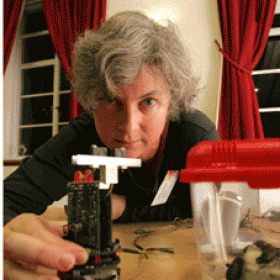Nature’s insect navigators inspire robots that find their own way

Prof Barbara Webb (School of Informatics) and colleagues have recently published a study showing how insects' eyes and brains process how sunlight scatters as it travels through the atmosphere, forming a pattern of polarised light. Observing variations in this light pattern enables insects to determine their direction at each stage of their journey. Insects combine this sense of direction with step counting, enabling them estimate the distance and direction home. They can do this even after travelling a long way on random routes, over rough terrain, or carrying heavy loads.
Researchers tested their findings by comparing simulations to real-life journeys made by ants and found that insects can determine their direction to within two compass degrees. Their findings could help develop a cheap low-power alternative to GPS for self-guided devices and will be used to build a prototype sensor for testing on robots in outdoor spaces.
Prof Barbara Webb said: “Insects have evolved eyes and brains that can accurately extract compass information from daylight, allowing us to copy this mechanism for navigating robots.”

